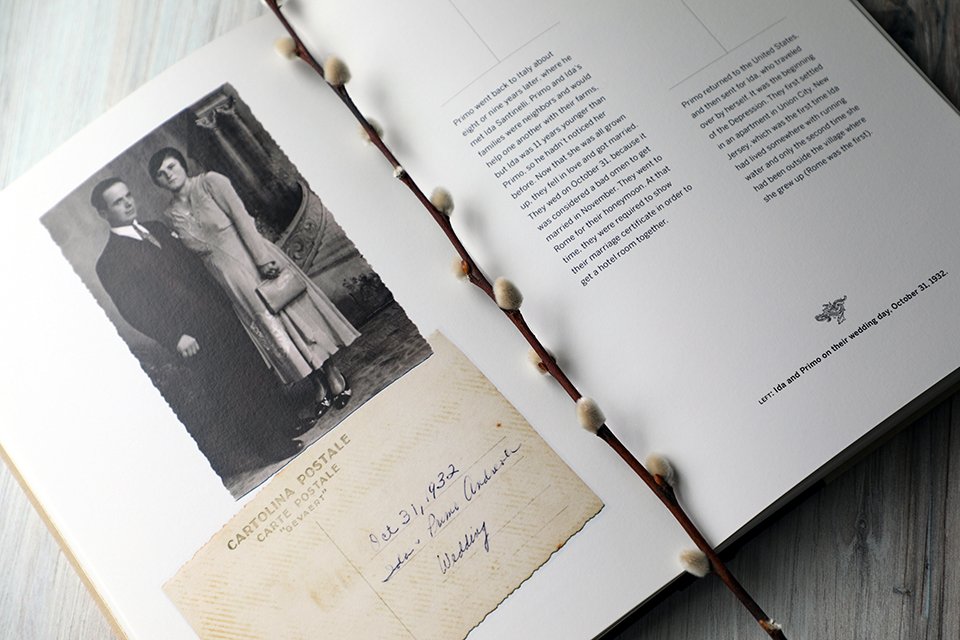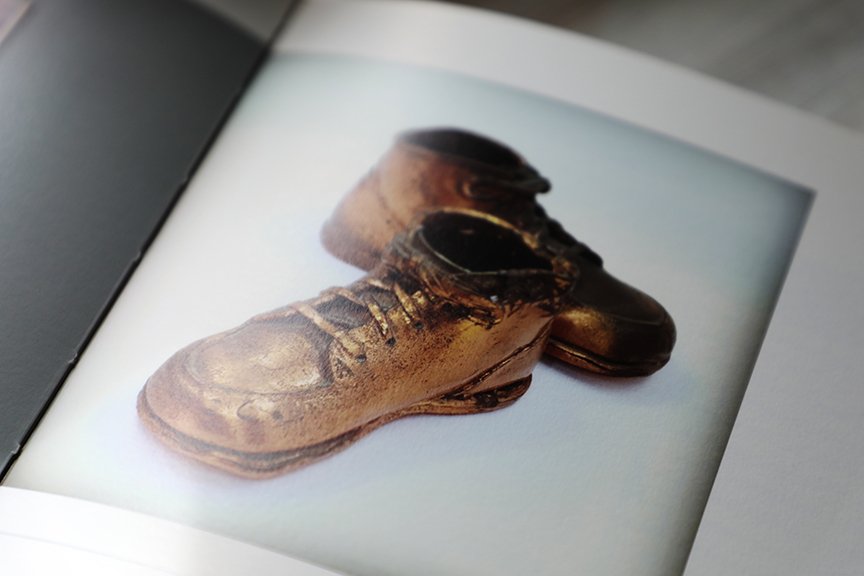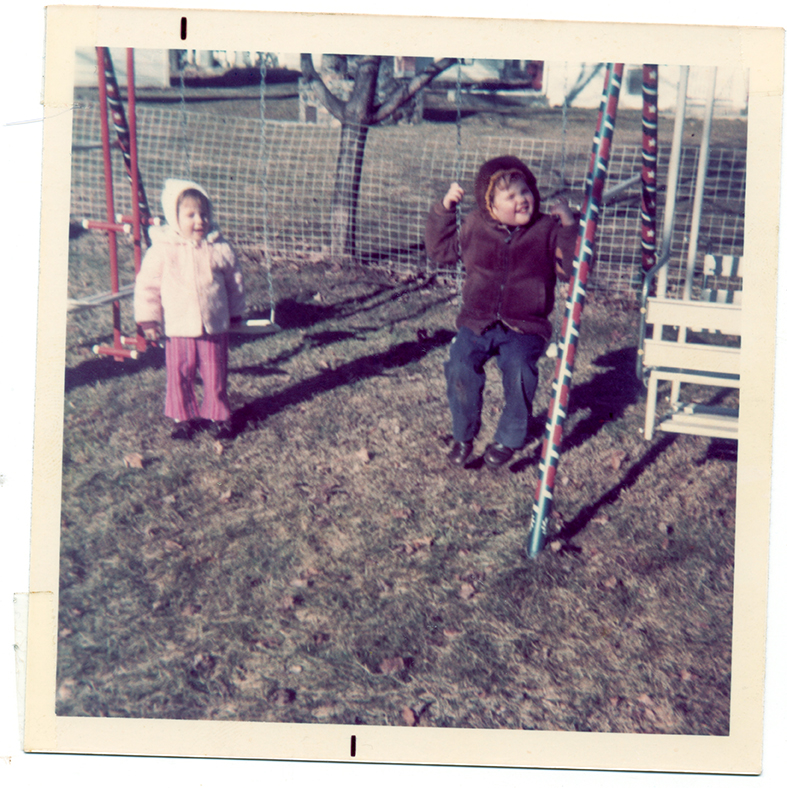Wait, your photo book has no captions?
Whether your photo book includes current snaps for a family yearbook or older images for a family history retrospective like this one, it’s important to include some captions. Design with ample white space and classic typefaces for an engaging and modern feel.
If you do an annual photo book, you’re way ahead of most people in the memory-keeping game—so big props to you! I am a vocal proponent of printing your photos rather than letting them languish amidst a ton of digital clutter on your phone, and getting them into a printed book is a wonderful way to preserve memories for your kids and yourself.
It’s what you’re creating your memory books for, isn’t it? To be able to look back one day and recall the moments big and small from your family’s life? To create a record of your experiences, and celebrate the milestones? To revisit travels and everyday occasions one day in the future?
Well, imagine this: It’s ten years hence, and your daughter is about to graduate from high school. You sit down together and pull out a family photo book from her childhood. What was that teacher’s name? How about that friend she was inseparable from for a whole year? Where was that awesome waterfall you climbed all day to see?
Or this: It’s 30 years from now and your son has recently become a new dad. He’s curious about what his father was like, and if he himself had as much hair as his newborn. You dig out one of your earliest family albums (hopefully you’ve made an extra copy for your son to have, too 😉) and you start reminiscing. But which baby is that in the stroller? Was that photo of your toddler son walking from when he was 10 months or over a year old?
All those details that are so fresh and obvious to you now while you are putting your photo book together won’t be so obvious down the road. Chances are you’ll forget a lot of the nitty-gritty things like places, dates, and ages—and there’s no chance that your kids (or their kids!!) will know if they’re not written down.
Ugh, you’re thinking—what a royal pain in the @$%. I have to write everything down?
No, you don’t have to write everything down. But some things? Sure. Consider doing so a gift to your kids. Adding some captions to your photo book ups the value from a “nice” album to an “invaluable” family heirloom.
The two types of captions every photo book needs
The purely informational caption
You don’t need to type names and dates for every photo—not only would that be time-consuming, it’d be rather boring.
Consider creating sections for every month in your annual family photo book, and titling each section accordingly; you can include specific dates when photos represent milestones such as weddings, Bat Mitzvahs, or graduations (and if you scan a ticket or program that includes the date, you’re covered!).
As far as names go, always include names of new babies when they are first pictured, of close friends or schoolmates alongside your kids, and of family elders who aren’t part of your immediate clan.
Type out locations when you think it might be interesting—perhaps you’d like to revisit that hotel in Hawaii, or take that hike again with the grandkids one day. You can use lots of discretion here, but consider when making your decisions about what to include: If I were looking at my parents’ photo books, would I be curious about this?
The storytelling caption
As a personal historian, you might guess that these are my favorite types of captions, and you’d be right. Rather than get intimidated by the idea of telling a story, consider these ideas:
Choose one photo or series of photos from each month of your family yearbook to elaborate on. If your son’s soccer team made it to the finals and lost by one goal, tell us about it in a sentence or two (include the details of what happened, as well as how he was feeling—proud? disappointed?). If you have a cluster of pictures of family members lounging around the house, talk about it—believe it or not, looking back on everyday moments such as this can feel even more special years from now!
Another option: Have each family member write a few sentences about their favorite memories from the year. It can be off-the-cuff and more emotional (certainly there were plenty of emotions during the early parts of quarantining in 2019, for example); or you can let each person choose one or two photos to spark stories. You might scan their handwritten notes to include as caption-like images, or type out their responses for more traditional captions.
Keep a running list in the Notes app on your phone of memorable quotes from your kids and others throughout the year. You can then incorporate these into your family photo book near appropriate images—voila, ready-made captions that preserve your family voices.
If you want to go even deeper with your storytelling, download my free guide, “How to Use Photographs as Prompts for Writing Life Stories”; and if you’d like to see an example of how you can say a LOT in just 200 words, check out the extended caption in this post.
How to keep your photo book design modern and clean, even with captions
I can think of two main reasons someone might forego including captions altogether: (1) it will be too time-consuming (to which I say: your efforts will be rewarded!); and (2) it will make my layout look too busy (to which I say: read the tips below!).
For some guidance on designing clean, clutter-free book layouts, I enlisted the help of Ontario–based graphic designer Mei Mei Wood, whose aesthetic, like ours at Modern Heirloom Books, is one of timeless elegance.
Here are her top tips for creating a photo book that looks clean and modern, even with the addition of text:
Use one classic font family that has a variety of weights and italics.
“This allows you to style typography in different ways throughout a piece of work, while staying consistent and keeping things simple,” Mei Mei says. Choosing classic typefaces—such as Baskerville or BentonSans (see examples at bottom of page)—also ensures that your book will feel timeless.
Embrace white space.
Oh, Mei Mei, you are singing my tune!! “I can't say this enough: Don't fill your pages with elements. Leave breathing room for your eyes.” Amen.
Always pare back.
“Less is more,” Mei Mei says. “One of the greatest tips I've heard: When you've written something, cut it in half. Then half that again. When you think you can't possibly cut it down any further, reduce it by half again. That's how you figure out what the message truly is.” Such editing can be challenging, though, so I recommend giving yourself a few days between writing your captions and then cutting them down—that distance will help give you perspective and allow you to recognize anything extraneous in your text. “I know this is extremely difficult with ancestry-based memory-keeping projects because the instinct is to preserve as much as possible. But it really is about revisiting work multiple times over a period of days and paring back to what’s essential,” she says.
Incorporate pull quotes.
Again, Mei Mei zeroes in on an easy design approach that pros use that most people don’t think of: “Highlight an important line or two in the layout. It's so visually impactful and can shine a light on what's important.” Pull quotes—short snippets of text that are designed in a larger type size—work well with large blocks of text or alongside a handwritten letter or journal entry.
An example of a serif font family with various weights
An example of a sans serif font family with various weights
A graphic pull quote can accompany an enlarged photo such as this, or can go alongside a block of text or handwritten letter to create visual interest and an emotional touchpoint for someone just flipping through your photo book.

































Sure, smart phone memory is getting cheaper—but is that reason enough to save every photo in an endless scroll? Don’t lose your memories amidst digital clutter!